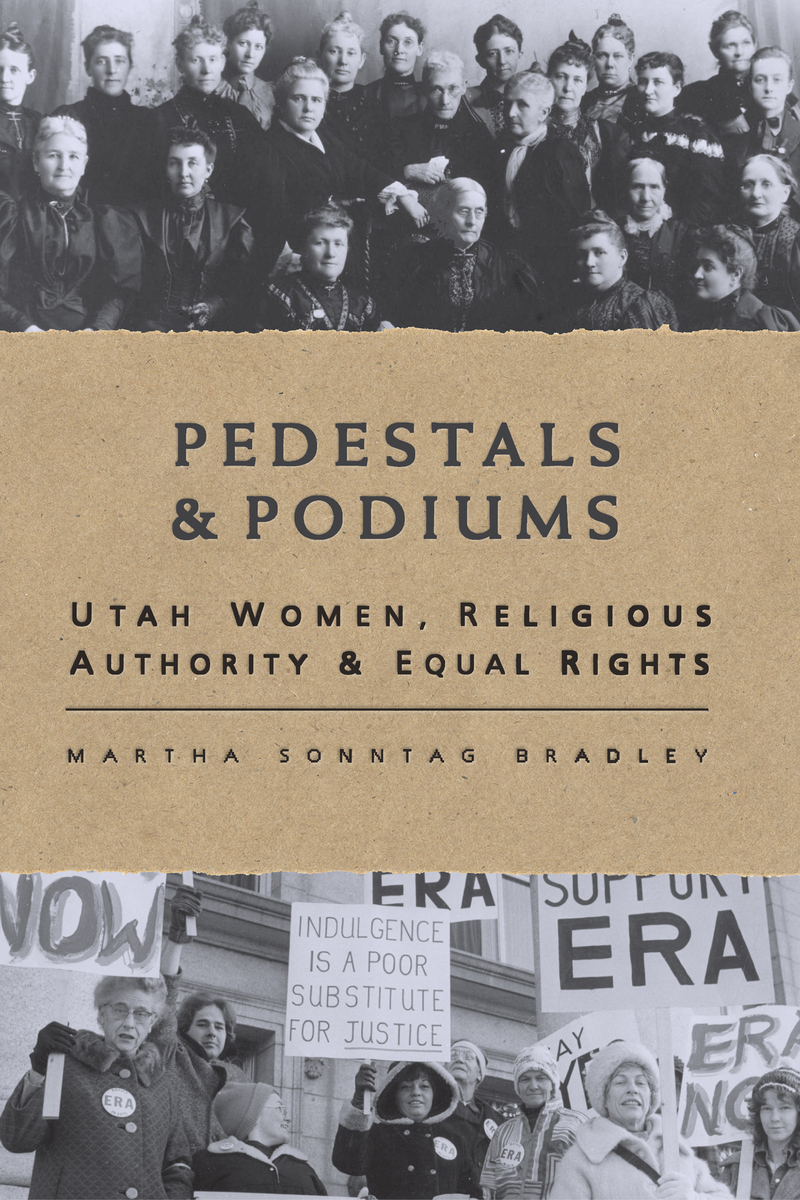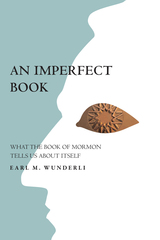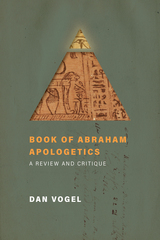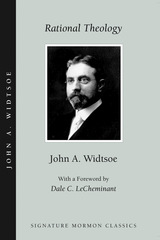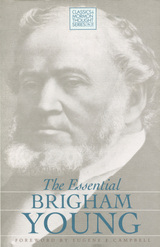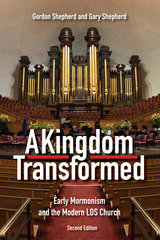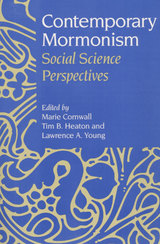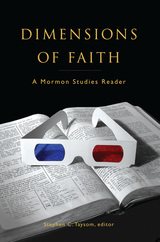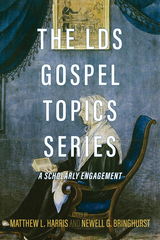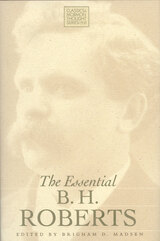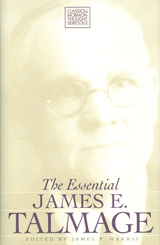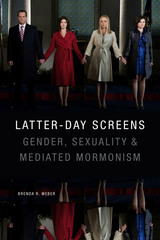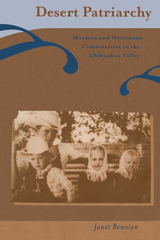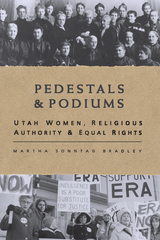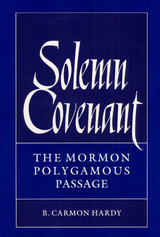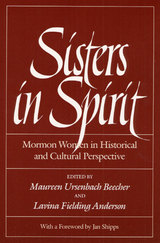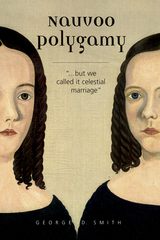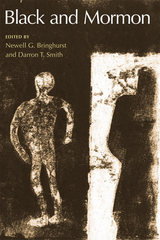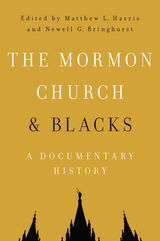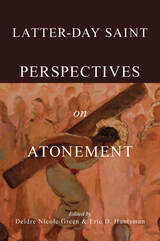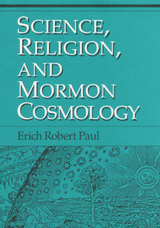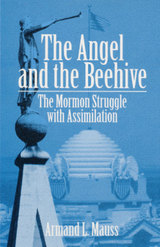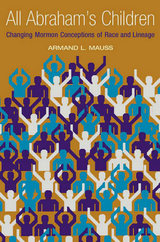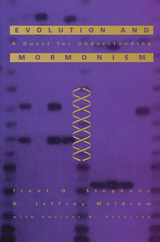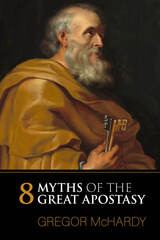eISBN: 978-1-56085-301-5 | Cloth: 978-1-56085-189-9
Library of Congress Classification BX8641.B73 2005
Dewey Decimal Classification 305.486893792
Looking back to the nineteenth century, how committed were Latter-day Saints of their day to women’s rights? LDS President Joseph F. Smith was particularly critical of women who “glory in their enthralled condition and who caress and fondle the very chains and manacles which fetter and enslave them!” The masthead of the church’s female Relief Society periodical,
Woman’s Exponent, proudly proclaimed “The Rights of the Women of Zion and the Rights of Women of All Nations!” In leading the LDS sisterhood, Wells said she gleaned inspiration from The Revolution,published by Elizabeth Cady Stanton.
Fast-forward a century to 1972 and passage of the Equal Rights Amendment (ERA) by the United States Congress. Within a few years, the LDS Church, allied with Phyllis Schlafly, joined a coalition of the Religious Right and embarked on a campaign against ratification. This was a mostly grassroots campaign waged by thousands of men and women who believed they were engaged in a moral war and that the enemy was feminism itself.
Conjuring up images of unisex bathrooms, homosexuality, the dangers of women in the military, and the divine calling of stay-at-home motherhood—none of which were directly related to equal rights—the LDS campaign began in Utah at church headquarters but importantly was fought across the country in states that had not yet ratified the proposed amendment. In contrast to the enthusiastic partnership of Mormon women and suffragists of an earlier era, fourteen thousand women, the majority of them obedient, determined LDS foot soldiers responding to a call from their Relief Society leaders, attended the 1977 Utah International Women’s Year Conference in Salt Lake City. Their intent was to commandeer the proceedings if necessary to defeat the pro-ERA agenda of the National Commission on the International Women’s Year. Ironically, the conference organizers were mostly LDS women, who were nevertheless branded by their sisters as feminists.
In practice, the church risked much by standing up political action committees around the country and waging a seemingly all-or-nothing campaign. Its strategists, beginning with the dean of the church’s law school at BYU, feared the worst—some going so far as to suggest that the ERA might seriously compromise the church’s legal status and sovereignty of its all-male priesthood. In the wake of such horrors, a take-no-prisoners war of rhetoric and leafleteering raged across the country. In the end, the church exerted a significant, perhaps decisive, impact on the ERA’’s unexpected defeat.
- _This is a story which has had strange and potent intersections with my life. In June 1977, I was a young mother with three children--my blonde wonder ready to begin kindergarten in the fall and two adorable daughters who were one and two years old. Purely by coincidence, I bumped into the women's movement the day I attended the Utah International Women's Year (IWY) Conference in Salt Lake City.
For me it was a stunning, shocking, stupefying day. From the beginning, I felt as if I had stumbled, then found a precarious new balance standing on a narrow bridge with dangerous drops on either side. It was a day of confusion and chaos-women crowded into hot rooms, often outnumbering the available seats. The aisles were an obstacle course of strollers in which babies fretted in the heat or slept in sweaty exhaustion. The din of speakers trying to make themselves heard, audience members responding and talking among themselves, wailing children, and the overflow noise from other rooms was mind numbing. It was one of those days when you're confronted head-on with how much you don't know.
The noise continued to wash over me as I stepped into the balloting booth. Confused, I read over the list of resolutions on the ballot I was supposed to vote for or against, but I realized I had not even begun to think about what my position as a woman in the world should be. Again I wanted--more than anything else, it seemed--to understand what it all meant.
That moment had a profound impact on my life which I vividly, even sensorially, recall, a moment that forever marked my life--a moment of "before" and "after." I became a feminist although I did not yet know what that implied. More than a decade would pass before I could begin to say understood the women's movement and even longer before I felt it was making a difference in my own life. But for my young, naive self, that warm June day was as defining a moment as I had ever experienced.
In the twenty-five years since then, I have heard other women speak of the eleven years between 1972 and 1983 in much the same way. For many of us, it was the decade when we were students or young mothers or were undertaking our first jobs. We were still shaping our lives. Perhaps we were more alert then, or focused on what mattered--on what held out the promise of meaning--but we knew this was deeply important ever when we were not exactly sure what "this" was. Women were talking about changing the world, and we believed we could have something to do with it.
At the same time, many of my friends seemed unaffected by what was going on around us. From what I could see, their lives proceeded as if nothing was in the air, as if their lives had absolutely nothing to do with those "other lives over there." In hindsight, the disconnection is remarkable to me and I have always wondered why feminism touched only some of us, why it does not seem to matter at all to many young women today.
For me, the time evoked memories of childhood. I am the only sister in a family of three brothers and I grew up headstrong and spirited, euphemisms of course for stubborn and difficult. I had all four adjectives thrown at me in various tones of voice and confess that I usually responded in kind. My mother and I squabbled endlessly over insignificant things. Still, my parents made me feel treasured and valued. The women's movement, on the most personal level, was a sturdy reminder that we women are powerful and talented, with hearts big enough to save the world. The messages of distrust and disrespect from other quarters were simply wrong.
Fifteen years after Utah's IWY conference, I delivered a paper in October 1992 on my experiences there at the LDS Church's Brigham Young University. This paper was based on a series of interviews my students and I had conducted with women who had helped plan the IWY conference, who had attended the conference themselves, or who were delegates to the national convention. The room at BYU was packed with women, many of whom I recognized. There were several women from the LDS Relief Society general board including Aileen Clyde, my personal heroine. Most of them I did not know; and I assumed, somewhat naively, that they were there because they were interested in the story. I was wrong.
After sociologist Marie Cornwall and I had delivered our separate papers and opened the session for questions, the room exploded into bedlam, it seemed to me. Accustomed to the traditional civility of academic discourse, I was surprised and dismayed. Women in the back and at both sides stood up and shouted sneering questions and criticisms that pierced the air like spit balls. I began to feel irrelevant to this exchange that seemed in some ways to be scripted. I felt as if I were disappearing into the wall behind me, and wished I could. The anger, the division, the bitterness, and the suspicions surrounding the IWY conferences and the Equal Rights Amendment (ERA) were being reenacted in front of my eyes. I found out later that many of these women had come to our session with the express purpose of disrupting it. Some had sent letters to the university president complaining about the topic and challenging the research money granted to support the research.
It would be seven years before I picked up this research again. It had proven to be a sort of hot potato each time I had touched it, and each time it had raised fresh blisters. But the story is compelling enough to draw me back again and again, demanding that I pay attention, that I find out what it had meant.
The issues seemed to be crystal clear to those in the pro and con camps. However, it is important to acknowledge the great range of responses among Mormon women. Some chose to become politically involved, join coalitions or committees, march at demonstrations, or lobby sessions of the legislatures. But far more women did nothing. The silence, which is like the apparently unruffled surface of a lake as storm wind build, is noteworthy. For thousands of Mormon women and other women throughout the country, the campaign against the ERA seemed simply irrelevant and uninteresting. They could not see its impact on their own lives which, for the most part, were contented and focused on practical tasks. The messages they heard coming from their church matched their own sense of their position in the world, particularly the Mormon world but they failed to perceive a threat and chose to not do anything at all. Why fix what was not broken?
Others faced the fight against the ERA as a sort of short-time assignment, not all that different from an assignment to show up at the church's Welfare Center for a day of canning apples or tomatoes. They supported the battle because they were asked to do so by church leaders whom they respected and, more importantly, obeyed, if called upon to do so. The church's concern about the position of women was a great comfort to them, an assurance in a world of change that they did not necessarily choose to understand or address. This was certainly true for me.
Good, faithful, intelligent women fell into both categories. Women worthy of anyone's respect, whom I greatly respect, willingly, even eagerly, accepted the church's position, supported the anti-ERA campaign or other church programs impacting the lives of women, and found ways to weave this narrative into their own personal stories or narratives that explained their lives.
Today, in many ways, the situation regarding women is less straightforward than it had been back in the 1970s. Those of us who still care about feminism inhabit a world that is seemingly indifferent. In some quarters, feminism is treated with more derision than devil worship; many others simply could not care less. Under the illusion that enough has been accomplished, that the position of women is good enough, many women and men alike seem to go about their lives without ever giving feminism a second thought.
Others are afraid to let their feminism show. As a teacher, I have heard students undercut their own positions on gender issues by prefacing their opinion with the little apology, "Now, I'm not a feminist, but ..." as if that means they would be crazy or off center if they were--that they would not be someone one could trust. At a recent conference, a middle-aged scholar prefaced her remarks with a similar disclaimer: "I don't want you to think I'm a feminist, but ..." What is it about feminism that creates such avoidance?
It has been disturbing to me, at this point midway through my life, to hear students, colleagues, even friends equivocate about women's rights. Perhaps the most damaging backlash, the result of the decade-long debate over the ERA, is the enduring stigma that still brands and dismisses the strong, bright, and articulate young women just emerging into the world. Identifying one's self as a feminist, as one did in the 1970s, can be risky business.
In 1979 Utah journalist Linda Sillitoe wrote a personal reaction to the excommunication of Mormon feminist Sonia Johnson that raised another important issue.1_Johnson, a Mormon mother with Cache Valley roots, was the founding president of Mormons for the ERA. Sillitoe decided to title her personal, privately circulated rumination "Don't Use My Name." A strong woman herself, but thinking of her own church membership, job, and family, Sillitoe reflected on what it meant to try to purge the bitterness over the injustice she had witnessed. The title was also drawn from dozens of interviewees who expressed strong feelings on the issue but masked themselves in anonymity for fear of retaliation. Might they suffer the same fate as Johnson and other women who spoke out? Might they be shunned by their local congregations? Might they be expelled from their church as Johnson was? They were not ready to take the chance. Sillitoe called this phenomenon the "invisibility factor," an idea she felt was key to understanding the psychology that ran through the 1970s and which continues to drive some women's (and men's) reactions to feminism.
Sillitoe noted the contradiction in being invisible: "The author cannot sign [her name], and to me that is the ultimate irony: that a statement of fear, love, and immobility must remain immobile--because of fear, and love." To understand how Mormon women felt about Sonia Johnson and her excommunication, Sillitoe spent hours on the telephone. "Interestingly," she wrote, "virtually every Mormon woman I have spoken with has assessed her own vulnerability, no matter how 'closet' a feminist and/or ERA supporter she might be--and none of them have been 'Sonia Johnsons.' Many softly blamed the bishop for their reticence, either because they were such good men or such unpredictable or vindictive men, whichever. Regardless, they felt endangered by the power the bishop held over them. They felt vulnerable."
The "general ignorance of the facts surrounding Sonia's excommunication" also surprised Sillitoe, who noted the "painful polarization" that pitted ERA supporters against supporters of the church, dividing families, friends, and wards and also, for some, defining their relationship to God. Despite a level of ignorance about the ERA itself, LDS church leaders relied on the collective force of obedient members who wielded tremendous political power in several key states--a power that reflected not the actual number of resident Mormons but the church's ability and will to mobilize the faithful to express the church's position through political action.
Although Mormon critiques of the ERA often read like legal arguments, church leaders from the beginning labeled the debate a moral issue--even while focusing almost exclusively on the appropriate role of the federal government, the use of law, and the meaning of the Constitution. True for the growing troops of the Christian Right that talked of "moral issues" but based its reasoning on legal arguments, the Mormon Church was joining a larger movement sweeping the country, reacting against the social change threatening the traditions on which America stood.2_The Mormon pronouncements were often prefaced by an appeal to free agency (i.e., free choice), but the implication was that a "good woman" would see only one real choice: to obey her inspired leaders and reject the ERA. The alternative was rebellion against the church or even against God and would certainly end in social and possibly ecclesiastical consequences. The result was that many ties of love and many years of conditioning tugged women in the direction these statements were intended to point them. Some feminists among the church membership were torn, feeling that theological beliefs nurtured by the church pointed them in the direction of fuller opportunities for women: the value of free agency, the ideal of eternal progression that did not accept social restrictions, woman-centered loyalty rooted in strong mother-daughter relations, and a love for the ideals of the Mormon women's Relief Society organization. But even those who moved into feminism_because of_the strength of their belief in Mormonism did so over daunting barriers of loneliness, agonized soul-searching, fear, and anger.
Interest in the ERA periodically resurfaces. The amendment died in 1982, but supporters continue to try to breathe life into the cause by lobbying the U.S. Congress and state legislatures. In the 1970s opponents of the ERA warned of dire consequences if it passed: co-ed bathrooms, women draftees, and the repeal of spousal support laws. Ironically, these social changes occurred without the ERA, including co-ed college dorms, women fighting beside men in Desert Storm, and alimony laws that are gender-neutral where need, contribution, and support issues are considered.
Mine is a generation that watched Billie Jean King trounce Bobby Riggs on the tennis court. Raised on_Donna Reed_and the_Brady Bunch,_we have taken notice of the subtleties of the_Cosby Show_as women began wearing suits to work and speaking from positions of power, expanding traditional roles to include more than tending husbands and children, to include public lives. Career opportunities, school funding, and sexual harassment became focal points of popular attention. Activists gave up on the 1970s issues of the ERA and reproductive rights--after all,_Roe_v. Wade_was the law of the land, with access to first-trimester abortion--and turned instead to the hot-button issues of child support, protection against domestic violence, stalking, and better justice in rape cases. Sexual abuse, a devastating plague that fell unequally on girls under eighteen, was no longer shielded by the secrecy surrounding unspeakable crimes. Political action committees helped elect more women to office. Female representation in legislatures shifted significantly.
As a result of these societal shifts, some now view the ERA as a historical relic, obsolete and irrelevant. With women sitting on the Supreme Court, running companies, and playing professional sports, the ERA might seem unnecessary. But for others, federal legislation remains essential. Even as a symbol, the amendment holds great potency. From the first, ERA supporters have asked the question: How much value and respect does the United States show women?
In the late 1990s, two states, Iowa and Florida, passed amendments in their state constitutions that, for the first time, included women. The ERA was re-introduced into the Illinois and Virginia legislatures and debated by the general assembly in Missouri. While the original debate over the ERA was raging in the early 1970s, Ruth Bader Ginsburg, at the time a professor of law at Columbia University but soon to become the second woman to sit on the U.S. Supreme Court, asserted that without a federal amendment there would not be an incentive to change laws that discriminate on the basis of gender. Writing in the 1973 issue of the_American Bar Association_Journal,_she noted that despite the passage of the Pay Equity Act, Title VII of the Civil Rights Act, and Title IX of the Education Act, hundreds of laws at both the state and federal levels continued to discriminate according to gender.
Court cases such as_Reed v. Reed_(1971) and_Frontiero v. Richardson_(1973), which Ginsburg helped to argue, caused legislatures to reconsider laws that differentiated on the basis of gender. Soon the U.S. Supreme Court ruled that, under the equal protection clause of the Fourteenth Amendment, laws containing gender-based classifications must have a demonstrably rational basis. In_Craig v. Boren_the Court raised that standard so that gender discrimination would have to be shown to be substantially related to important governmental interests. Finally, as a Supreme Court judge, Ginsburg wrote the court's majority opinion in_Virginia v._U.S.(1996), stipulating that gender-based discrimination requires an "exceedingly persuasive justification." The majority opinion struck down the barrier that had kept women from attending the formerly all-male Virginia Military Institute. Despite these advancements, gender discrimination is not as widely prohibited as discrimination based on race and ethnicity. The Fourteenth Amendment helped many but not all Americans. Without an amendment to the U.S. Constitution guaranteeing the equality of women, laws protecting women's rights could still be amended or even repealed.3
However, this book is not a treatise on the continuing need for an Equal Rights Amendment. Rather, it traces the high-voltage intersection of two national trends--feminism and the Christian Right, with a focus on Mormonism--during a vivid decade in American history.
Nationally-known African-American feminist writer bell hooks indicates how nuanced the status of women in the United States is:
Many women do not join organized resistance against sexism precisely because sexism has not meant an absolute lack of choices. They may know they are discriminated against on the basis of sex, but they do not equate this with oppression. Under capitalism, patriarchy is so structured that sexism restricts women's behavior in some realms even as freedom from limitations is allowed in other spheres. The absence of extreme restrictions leads many women to ignore the areas in which they are exploited or discriminated against; it may even lead them to imagine that no women are oppressed.4
The goal of feminism, according to hooks, has been to ensure that all people enjoy the same range of choices as those in the most privileged class. This can only be accomplished through a reordering of society to replace alienation, competition, and dehumanization with "intimacy, mutuality, and camaraderie."5
Besides the battle over the ERA, the formation by the United Nations of a commission to study the status of the world's women engendered the so-called International Women's Year and stimulated a worldwide discussion on the status of women. In the United States this included a series of statewide conferences and a climactic show-down in Houston, Texas, the country's first national conference on the status of women since the battle for suffrage two generations earlier. A survey conducted in advance of the Houston meeting by the National Organization of Women indicated that the ERA, reproductive rights, and other controversial feminist ideas would be endorsed overwhelmingly at the conference. And they were. But the conservatives, who sensed a liberal agenda, reported that they felt invalidated and excluded. In fact, the decade was one of profound division among women over issues that impacted their lives directly. The lingering effects are with us still.
Much of this turbulence fell during the administration of LDS President Spencer W. Kimball, a gentle and beloved leader, twelfth president of the American-based church of 3.2 million members worldwide at that time. The_Los Angeles Times_ran a feature story about him in 1974 where he attained leadership at age seventy-nine. Kimball, who was born at the end of the nineteenth century, said he felt called to counter such social ills as "the loosening of the marital bonds and juvenile delinquency." The church had always stressed the importance of the family unit in its faith structure even though the ideal family unit in the nineteenth century was polygamy. Thus, social change had affected the Mormon people in a particular way. "We try to be not of the world," President Kimball told the_Times,_"but it's impossible to be entirely unaffected by it. We have some broken homes, some divorces, some immoralities at times. We try to handle it." He emphasized that the LDS woman, within the family, was not a second-class citizen. "While we stress the importance of the woman's role in the family life, which is basic, we don't make them servants, and we don't force them to work, or to leave off all the other things. ... They are cultured, and in many cases they've studied." Young women, he said, were allowed to become missionaries when they turned twenty-three, compared to nineteen years of age for young men, although "they are not encouraged to do so," he acknowledged.6_He said he himself was married to a strong woman, Camilla Eyring Kimball, who despite her traditional lifestyle of family care, gardening, baking bread, and bottling vegetables was also well-known for her intellectual curiosity, insatiable reading, and steady accumulation of university courses.
Less than three years after the_Times_article, the_Salt Lake Tribune_published a piece headlined "BYU Women Oppose ERA, Survey Says, Men Prefer 'Pretty Faces.'" This disconcerting survey of women students at BYU revealed that 76 percent opposed the ERA but that 86 percent said they had been the victims of sexual discrimination. Shirleen Jones from Pingree, Idaho, worried about the negative side effects of the ERA. "It might take women out of the home," she said. Gretchen Pike of Pelham, New Hampshire, said: "Women belong in the family, supporting their husbands and raising their children, not going off being selfish and thinking of themselves." A poll of the men was especially telling. When asked about their ideal mate--the girl they wanted to marry--100 percent said physical attractiveness was vital. When asked, "What is the first thing you look for in a girl?" they responded variously, most emphasizing "a good figure and a pretty face," while three said "intelligence" and four said spirituality or a "strong testimony" were important. Dean Brown of Culver City, California, explained; "It is said that if given a choice between marrying an ugly girl with a good spirit or a cute girl with no spirit, marry the cute one because you can give a girl a good spirit, but you can't give an ugly girl good looks."7
Several years earlier, the LDS magazine for adolescents, in an article titled, "What Is a Girl Good For?" proposed that this was a question "the young woman of today asks":
One hears a lot of talk about what today's girl is good for. One sees the word in print. But opinions vary greatly. Girls are counseled to marry and have families--to fulfill the measure of their creation. But if they do, they are charged with adding to the problem of the population explosion. They are taught the same subjects as boys in school and trained to compete with them in the world of commerce. On the other hand, they are reminded that their place is in the home. What is the truth? The dichotomy can be disconcerting.8
In this gendered discussion, author Elaine Cannon explained:
One thing of which an LDS girl is certain is that her role in the Church and in life will always be different from that of a boy. She has not been given the priesthood. God's power is not used through her exactly as it is in men. But a girl does have a power. Hers is the power to bear children, yes, but also to love, and with heart and hand to comfort, teach, and train, to heal and care for both old and young, man, woman, and child alike, wherever her service may take her.
Thus, service rather than leadership was ultimately what a "girl is good for."
Perhaps this kind of language and imagery should not sadden me, but I confess that it does. Is not service part of being human? Should service not be what boys are good for? The evident difficulty in identifying what a "girl is good for" injures women and men alike. Women are good for everything, not because someone finds the words to tell them they are, but because it is already in them to be so. Most importantly, the discourse about the position of women in the Mormon world was argued with rhetoric which failed to satisfactorily explain the difference.
Women of my generation grew up in households with mothers whose sense of self was tied to 1950s obligations of perfect womanhood. To those of us following them, the messages by which our mothers lived seemed contradictory and even destructive. Consider, for example,_Fascinating_Womanhood,_Helen B. Andelin's advice for the perfect woman, a book that sat on the bookshelf in our family room next to Steinbeck, Faulkner, and recordings of Mario Lanza. Like the other books, I took down_Fascinating Womanhood_and read it. I watched eagerly to see if my mother asked my father for help because he was "stronger." I had seen her move a piano by herself and knew she could do anything she set her mind to. But I was suspicious of her every move for a while.
The LDS_Church_News, published weekly, celebrated Andelin's willingness to speak out against "women's liberation" in a day when other religious women seemed reticent to challenge the more experienced public debaters of feminism. Andelin was the mother of eight children, three at BYU or on LDS missions in the 1970s. "In feel strongly that the women's lib movement will fail," she told the_Church News._"Everything they stand for is against the basic role of women. They want to do away with this woman's place in the home, yet without the structure of the home, the whole nation would be weakened." She questioned feminism's position on individual freedom, which argued that wives and mothers lose freedom by choosing to be full-time care givers and homemakers. "We need woman power in the home," she asserted. "If a woman will stay in the home and make a career out of it, she has the ability as a mother to make the world a different place."9
Andelin said she had come across a series of booklets written in the 1920s called "The Secrets of Fascinating Womanhood," with ideas about how to manage happier marriages. She combined these insights with her own background in Mormonism and experience as a wife and mother to begin holding seminars for women. Soon her seminars were overflowing with as many as 170 eager disciples at a time, and church members clamored for her how-to advice for a happy marriage. Her resulting book,_Fascinating Womanhood,_fit well with other conservative attempts to protect the American family in the wake of the Cold War and with the Mormon spin on what had been called the cult of true womanhood.10_Andelin portrayed her ideal woman as one who knew how to keep her man happy by making him think he was stronger and cleverer--that she should pretend to wilt and expire in the absence of his manly protection. For many women troubled by an unfulfilled marriage or the specter of rising divorce rates,_Fascinating_Womanhood_promised to create unbreakable bonds of domestic romance. For many other women, troubled by the deceit and manipulation they were asked to deploy,Fascinating Womanhood_was asking them to compromise their integrity in the name of the family.
A student editorial appearing in December 1977 in the University of Utah's_Daily Chronicle_captured this failure to take women seriously. The anonymous writer, who described herself as a "Houston observer," blamed the media for failing to present the truth of the women's movement. "The media has made every attempt to make a sham of the women's movement either by reducing it to a ridiculous group of bra burning malcontents or militant man-hating tigers." She criticized the press for distinguishing between "pro-family" Utahns and anti-family feminists when the latter were equally family friendly. With convenient sound bites, society had effectively boxed up women into tight little packages that didn't leave any room for individuality, personal expression, or growth. Both sides did it.
What I offer in this book is my own vantage point in the continuing debate over the rights and responsibilities of Mormon women, a debate that is politicized, despite being conducted largely in a church setting, and one in which rhetoric has played a supremely important role. I hope my insights prove to be useful in clarifying of one position and a positive contribution to that debate.
This project has benefited greatly from the tremendous resources found in various archives and historical libraries. Clearly, women knew this decade carried significant weight. Many knew they were making history and acting on a national stage. They kept their records. Many women gave their files to the Utah State Historical Society, the University of Utah, or Brigham Young University. Thus, an immense and thorough record of these events is readily available for research. Many of the relevant files planned for disposal by the LDS Church archives ended up at the University of Utah's Special Collections and are therefore also available for the use of researchers.
Beginning in 1992, several of my students and I interviewed women who have been a part of this story. These interviews are still in my possession on tape and in typescript, although not yet in a finalized form. They are destined to become part of the documentary record in the Harold B. Lee Library at BYU. In my source notations, these are designated as part of the "IWY Project." The voices captured in these interviews lend additional power to the narrative, otherwise drawn from official documents, newspaper reports, and secondary sources; and their vivid sensorial memories add an important element to these events. It was not infrequently that my students and I sat with someone who, in remembering these painful years, allowed tears to flow unchecked while she recalled what had occurred--what she had cared about or worked for and what had changed or not changed since that time. The interviews were sponsored in part by support from the BYU Women's Research Institute and the University of Utah. They represent a balance between conservative and liberal voices, professional women and stay-at-home mothers, students and elderly women. Every attempt was made to be fair in the choice of women to interview and whose voices would contribute to this narrative. Many of the women we interviewed gave us their personal files, shared their letters and journals with us, and gave us the boxes of books, pamphlets, and papers they had saved all these years. Again, they knew these records were important, that they had helped shape history. It has been one of the rich rewards of researching this history that so many of the players are still alive, have continued to play public roles, and have reflected seriously on the significance of that decade.
The documentary record includes a huge outpouring of official publications from the LDS Church, but it has not been easy to detect the personal input of individual church leaders. Spencer Kimball, for example, made only infrequent mention of the church's campaign against the ERA in his journal.11_There are almost no personal responses available from other significant players on the General Authority level. That part of the story is left for someone else to write.
As important as the events beginning in the late 1970s is the historical context for these developments, which is why nineteenth-century views of women and female activism, both nationally and within the LDS Church, are the subject of the first chapter in this book. Opponents and proponents of the ERA have both used Mormon history to prove their points. It is important to know the historical relationship of Mormon women to their church and their early participation in the women's movement, as well as how the church interpreted a woman's role and the issues that were important to both. The second chapter describes the efforts by national activists in passing an equal rights amendment beginning in the 1920s and continuing to the 1970s.
I found that, in key ways, the campaign against the ERA was a battle fought rhetorically with alternative imagery portraying the role of women, the nature of woman, and the potential impact of an equal rights amendment on the position of women in the world. Chapter 3 analyzes the rhetorical arguments, media, and discourse employed in this struggle, particularly the rhetorical stance of the Mormon Church in its anti-ERA campaign of the 1970s.
The next several chapters span the years between 1972 and 1983 and detail the campaigns, including the anti-ERA effort organized by the Special Affairs Committee of the LDS Church in Iowa, Florida, Nevada, New York, Virginia, and other key states in the ratification effort. These chapters focus as well on the mid-1970s when IWY conferences were held internationally within each participating nation and in each state of the Union. The final chapters focus on the efforts of individual Mormon women to organize in opposition to the church's official position in such organizations as Mormons for ERA (MERA); the story of MERA's most prominent leader, Sonia Johnson; and one women's group in Utah, the Alice Louise Reynolds Forum, which provided an outlet for those who were reevaluating their lives as LDS women in the wake of the decade's disturbance and the church's campaign.
Ironically, I can fully relate to both of the opposing points of view. I spent fifteen years as a "stay-at-home mother" and the next several years to the present time as a professor. My sense of a woman's life is that it is rich with choices, complex with competing pulls on her time and energy, but that it also holds out rich rewards. It is true that the LDS Church's campaign against the ERA was one of many. In important ways it mirrored the efforts of others--Protestant religious groups, conservative political action committees, and special interest organizations that first formed to fight the ERA and then transferred their attention and focus to other issues on the American political landscape. I will not anywhere in this book say that this campaign was wrong, but will instead try to understand how it worked and the impact it had on individual women's lives, the position of Utah in the context of Mormonism and Utah society, and the long-term implications of such a campaign on the women's movement more generally. In large measure, this was a war of words. But they were words that ripped apart women's lives, threatened to destroy their self-respect or dignity, and that divided women from each other in profoundly important and meaningful ways. Originally motivated by fear of change, one of many deep and weighty transformations was that women became afraid of each other. Rather than searching for common ground, this was a time when women pulled apart, believed the rhetoric of suspicion and alarm, and contributed to the dichotomies that separated feminists from more traditional women and rendered them powerless at reaching reconciliation.
It has been thirty years since the ERA was passed by the U.S. Senate and House of Representatives. I have heard countless women speak of that period as if it were their coming-out party. Regardless of where each woman positioned herself, it was a time of social upheaval and change. It forced Americans to examine the ways we relate to each other as men and women, our relationship to the law, the ways we build community, and our options in negotiating marriages and raising children. Many women had experiences similar to mine through events like the IWY that caused a sea of change in their lives. Set adrift, women rewrote their scripts or took decades to begin to process and consider what it had meant for them. For others, the turbulence of the change and the violence of the backlash made them cling more tightly to traditional religion and family structures as a source of stability and meaning.
The willingness of the women to share their stories made this book possible. For many, these stories were intensely personal and painful. Other women have chosen to keep their stories private and untold. For those who shared, I value their gifts and respect both the giver and the responsibility that comes with hearing. Their stories will become part of the reader's understanding as we all find our lives inextricably linked. What we women did, separately and together, impacted all of us.
Among many to whom I am indebted are first of all the staff of the University of Utah's Special Collections archives in the Marriott Library. They were particularly helpful in passing on box after box of rich materials for my perusal. They were infinitely patient as I repeatedly exclaimed:
"Can you believe this?" or "Look at this!" Much of it was really too good to believe--exactly on topic. I was deeply moved by the sense of historical significance that prompted women such as Linda Sillitoe, Sonia Johnson, Sharon Kreigher, and Kathryn MacKay to save their correspondence, the pamphlets they picked up at various demonstrations, and their personal notes. They knew the importance of this story.
Lavina Fielding Anderson's fine ethical and moral sense is evident throughout this manuscript through her editing, her friendship, and her leadership. She is an endless source of inspiration and wisdom. The Signature Books team made the final stage of the production of this book a grand ride. Ultimately, they make it happen, and they always make it excellent, rewarding, and right.
As always, my children also made this book possible. The first three were babies when this story began, and the last three are now adults, my friends and strength. It was perhaps necessary that I complete this project--despite the many disruptions and temptations to push it aside--because of these children: my two amazing sons--Jason and Patrick--my four powerful daughters--Elizabeth and her husband Mark, Rachael, Emily and Jerol, and Katelyn--and the woman my son Jason married Sharley; the woman with whom Patrick may some day make his life; grandchildren Aspen, Dylan, Kristin, the beautiful new baby girl, Stella Rose; and the others who will come. For me, the women's movement was about making a rich, full life possible for every one of us. It is a journey that is still incomplete.
For me it was a stunning, shocking, stupefying day. From the beginning, I felt as if I had stumbled, then found a precarious new balance standing on a narrow bridge with dangerous drops on either side. It was a day of confusion and chaos-women crowded into hot rooms, often outnumbering the available seats. The aisles were an obstacle course of strollers in which babies fretted in the heat or slept in sweaty exhaustion. The din of speakers trying to make themselves heard, audience members responding and talking among themselves, wailing children, and the overflow noise from other rooms was mind numbing. It was one of those days when you're confronted head-on with how much you don't know.
The noise continued to wash over me as I stepped into the balloting booth. Confused, I read over the list of resolutions on the ballot I was supposed to vote for or against, but I realized I had not even begun to think about what my position as a woman in the world should be. Again I wanted--more than anything else, it seemed--to understand what it all meant.
That moment had a profound impact on my life which I vividly, even sensorially, recall, a moment that forever marked my life--a moment of "before" and "after." I became a feminist although I did not yet know what that implied. More than a decade would pass before I could begin to say understood the women's movement and even longer before I felt it was making a difference in my own life. But for my young, naive self, that warm June day was as defining a moment as I had ever experienced.
In the twenty-five years since then, I have heard other women speak of the eleven years between 1972 and 1983 in much the same way. For many of us, it was the decade when we were students or young mothers or were undertaking our first jobs. We were still shaping our lives. Perhaps we were more alert then, or focused on what mattered--on what held out the promise of meaning--but we knew this was deeply important ever when we were not exactly sure what "this" was. Women were talking about changing the world, and we believed we could have something to do with it.
At the same time, many of my friends seemed unaffected by what was going on around us. From what I could see, their lives proceeded as if nothing was in the air, as if their lives had absolutely nothing to do with those "other lives over there." In hindsight, the disconnection is remarkable to me and I have always wondered why feminism touched only some of us, why it does not seem to matter at all to many young women today.
For me, the time evoked memories of childhood. I am the only sister in a family of three brothers and I grew up headstrong and spirited, euphemisms of course for stubborn and difficult. I had all four adjectives thrown at me in various tones of voice and confess that I usually responded in kind. My mother and I squabbled endlessly over insignificant things. Still, my parents made me feel treasured and valued. The women's movement, on the most personal level, was a sturdy reminder that we women are powerful and talented, with hearts big enough to save the world. The messages of distrust and disrespect from other quarters were simply wrong.
Fifteen years after Utah's IWY conference, I delivered a paper in October 1992 on my experiences there at the LDS Church's Brigham Young University. This paper was based on a series of interviews my students and I had conducted with women who had helped plan the IWY conference, who had attended the conference themselves, or who were delegates to the national convention. The room at BYU was packed with women, many of whom I recognized. There were several women from the LDS Relief Society general board including Aileen Clyde, my personal heroine. Most of them I did not know; and I assumed, somewhat naively, that they were there because they were interested in the story. I was wrong.
After sociologist Marie Cornwall and I had delivered our separate papers and opened the session for questions, the room exploded into bedlam, it seemed to me. Accustomed to the traditional civility of academic discourse, I was surprised and dismayed. Women in the back and at both sides stood up and shouted sneering questions and criticisms that pierced the air like spit balls. I began to feel irrelevant to this exchange that seemed in some ways to be scripted. I felt as if I were disappearing into the wall behind me, and wished I could. The anger, the division, the bitterness, and the suspicions surrounding the IWY conferences and the Equal Rights Amendment (ERA) were being reenacted in front of my eyes. I found out later that many of these women had come to our session with the express purpose of disrupting it. Some had sent letters to the university president complaining about the topic and challenging the research money granted to support the research.
It would be seven years before I picked up this research again. It had proven to be a sort of hot potato each time I had touched it, and each time it had raised fresh blisters. But the story is compelling enough to draw me back again and again, demanding that I pay attention, that I find out what it had meant.
The issues seemed to be crystal clear to those in the pro and con camps. However, it is important to acknowledge the great range of responses among Mormon women. Some chose to become politically involved, join coalitions or committees, march at demonstrations, or lobby sessions of the legislatures. But far more women did nothing. The silence, which is like the apparently unruffled surface of a lake as storm wind build, is noteworthy. For thousands of Mormon women and other women throughout the country, the campaign against the ERA seemed simply irrelevant and uninteresting. They could not see its impact on their own lives which, for the most part, were contented and focused on practical tasks. The messages they heard coming from their church matched their own sense of their position in the world, particularly the Mormon world but they failed to perceive a threat and chose to not do anything at all. Why fix what was not broken?
Others faced the fight against the ERA as a sort of short-time assignment, not all that different from an assignment to show up at the church's Welfare Center for a day of canning apples or tomatoes. They supported the battle because they were asked to do so by church leaders whom they respected and, more importantly, obeyed, if called upon to do so. The church's concern about the position of women was a great comfort to them, an assurance in a world of change that they did not necessarily choose to understand or address. This was certainly true for me.
Good, faithful, intelligent women fell into both categories. Women worthy of anyone's respect, whom I greatly respect, willingly, even eagerly, accepted the church's position, supported the anti-ERA campaign or other church programs impacting the lives of women, and found ways to weave this narrative into their own personal stories or narratives that explained their lives.
Today, in many ways, the situation regarding women is less straightforward than it had been back in the 1970s. Those of us who still care about feminism inhabit a world that is seemingly indifferent. In some quarters, feminism is treated with more derision than devil worship; many others simply could not care less. Under the illusion that enough has been accomplished, that the position of women is good enough, many women and men alike seem to go about their lives without ever giving feminism a second thought.
Others are afraid to let their feminism show. As a teacher, I have heard students undercut their own positions on gender issues by prefacing their opinion with the little apology, "Now, I'm not a feminist, but ..." as if that means they would be crazy or off center if they were--that they would not be someone one could trust. At a recent conference, a middle-aged scholar prefaced her remarks with a similar disclaimer: "I don't want you to think I'm a feminist, but ..." What is it about feminism that creates such avoidance?
It has been disturbing to me, at this point midway through my life, to hear students, colleagues, even friends equivocate about women's rights. Perhaps the most damaging backlash, the result of the decade-long debate over the ERA, is the enduring stigma that still brands and dismisses the strong, bright, and articulate young women just emerging into the world. Identifying one's self as a feminist, as one did in the 1970s, can be risky business.
In 1979 Utah journalist Linda Sillitoe wrote a personal reaction to the excommunication of Mormon feminist Sonia Johnson that raised another important issue.1_Johnson, a Mormon mother with Cache Valley roots, was the founding president of Mormons for the ERA. Sillitoe decided to title her personal, privately circulated rumination "Don't Use My Name." A strong woman herself, but thinking of her own church membership, job, and family, Sillitoe reflected on what it meant to try to purge the bitterness over the injustice she had witnessed. The title was also drawn from dozens of interviewees who expressed strong feelings on the issue but masked themselves in anonymity for fear of retaliation. Might they suffer the same fate as Johnson and other women who spoke out? Might they be shunned by their local congregations? Might they be expelled from their church as Johnson was? They were not ready to take the chance. Sillitoe called this phenomenon the "invisibility factor," an idea she felt was key to understanding the psychology that ran through the 1970s and which continues to drive some women's (and men's) reactions to feminism.
Sillitoe noted the contradiction in being invisible: "The author cannot sign [her name], and to me that is the ultimate irony: that a statement of fear, love, and immobility must remain immobile--because of fear, and love." To understand how Mormon women felt about Sonia Johnson and her excommunication, Sillitoe spent hours on the telephone. "Interestingly," she wrote, "virtually every Mormon woman I have spoken with has assessed her own vulnerability, no matter how 'closet' a feminist and/or ERA supporter she might be--and none of them have been 'Sonia Johnsons.' Many softly blamed the bishop for their reticence, either because they were such good men or such unpredictable or vindictive men, whichever. Regardless, they felt endangered by the power the bishop held over them. They felt vulnerable."
The "general ignorance of the facts surrounding Sonia's excommunication" also surprised Sillitoe, who noted the "painful polarization" that pitted ERA supporters against supporters of the church, dividing families, friends, and wards and also, for some, defining their relationship to God. Despite a level of ignorance about the ERA itself, LDS church leaders relied on the collective force of obedient members who wielded tremendous political power in several key states--a power that reflected not the actual number of resident Mormons but the church's ability and will to mobilize the faithful to express the church's position through political action.
Although Mormon critiques of the ERA often read like legal arguments, church leaders from the beginning labeled the debate a moral issue--even while focusing almost exclusively on the appropriate role of the federal government, the use of law, and the meaning of the Constitution. True for the growing troops of the Christian Right that talked of "moral issues" but based its reasoning on legal arguments, the Mormon Church was joining a larger movement sweeping the country, reacting against the social change threatening the traditions on which America stood.2_The Mormon pronouncements were often prefaced by an appeal to free agency (i.e., free choice), but the implication was that a "good woman" would see only one real choice: to obey her inspired leaders and reject the ERA. The alternative was rebellion against the church or even against God and would certainly end in social and possibly ecclesiastical consequences. The result was that many ties of love and many years of conditioning tugged women in the direction these statements were intended to point them. Some feminists among the church membership were torn, feeling that theological beliefs nurtured by the church pointed them in the direction of fuller opportunities for women: the value of free agency, the ideal of eternal progression that did not accept social restrictions, woman-centered loyalty rooted in strong mother-daughter relations, and a love for the ideals of the Mormon women's Relief Society organization. But even those who moved into feminism_because of_the strength of their belief in Mormonism did so over daunting barriers of loneliness, agonized soul-searching, fear, and anger.
Interest in the ERA periodically resurfaces. The amendment died in 1982, but supporters continue to try to breathe life into the cause by lobbying the U.S. Congress and state legislatures. In the 1970s opponents of the ERA warned of dire consequences if it passed: co-ed bathrooms, women draftees, and the repeal of spousal support laws. Ironically, these social changes occurred without the ERA, including co-ed college dorms, women fighting beside men in Desert Storm, and alimony laws that are gender-neutral where need, contribution, and support issues are considered.
Mine is a generation that watched Billie Jean King trounce Bobby Riggs on the tennis court. Raised on_Donna Reed_and the_Brady Bunch,_we have taken notice of the subtleties of the_Cosby Show_as women began wearing suits to work and speaking from positions of power, expanding traditional roles to include more than tending husbands and children, to include public lives. Career opportunities, school funding, and sexual harassment became focal points of popular attention. Activists gave up on the 1970s issues of the ERA and reproductive rights--after all,_Roe_v. Wade_was the law of the land, with access to first-trimester abortion--and turned instead to the hot-button issues of child support, protection against domestic violence, stalking, and better justice in rape cases. Sexual abuse, a devastating plague that fell unequally on girls under eighteen, was no longer shielded by the secrecy surrounding unspeakable crimes. Political action committees helped elect more women to office. Female representation in legislatures shifted significantly.
As a result of these societal shifts, some now view the ERA as a historical relic, obsolete and irrelevant. With women sitting on the Supreme Court, running companies, and playing professional sports, the ERA might seem unnecessary. But for others, federal legislation remains essential. Even as a symbol, the amendment holds great potency. From the first, ERA supporters have asked the question: How much value and respect does the United States show women?
In the late 1990s, two states, Iowa and Florida, passed amendments in their state constitutions that, for the first time, included women. The ERA was re-introduced into the Illinois and Virginia legislatures and debated by the general assembly in Missouri. While the original debate over the ERA was raging in the early 1970s, Ruth Bader Ginsburg, at the time a professor of law at Columbia University but soon to become the second woman to sit on the U.S. Supreme Court, asserted that without a federal amendment there would not be an incentive to change laws that discriminate on the basis of gender. Writing in the 1973 issue of the_American Bar Association_Journal,_she noted that despite the passage of the Pay Equity Act, Title VII of the Civil Rights Act, and Title IX of the Education Act, hundreds of laws at both the state and federal levels continued to discriminate according to gender.
Court cases such as_Reed v. Reed_(1971) and_Frontiero v. Richardson_(1973), which Ginsburg helped to argue, caused legislatures to reconsider laws that differentiated on the basis of gender. Soon the U.S. Supreme Court ruled that, under the equal protection clause of the Fourteenth Amendment, laws containing gender-based classifications must have a demonstrably rational basis. In_Craig v. Boren_the Court raised that standard so that gender discrimination would have to be shown to be substantially related to important governmental interests. Finally, as a Supreme Court judge, Ginsburg wrote the court's majority opinion in_Virginia v._U.S.(1996), stipulating that gender-based discrimination requires an "exceedingly persuasive justification." The majority opinion struck down the barrier that had kept women from attending the formerly all-male Virginia Military Institute. Despite these advancements, gender discrimination is not as widely prohibited as discrimination based on race and ethnicity. The Fourteenth Amendment helped many but not all Americans. Without an amendment to the U.S. Constitution guaranteeing the equality of women, laws protecting women's rights could still be amended or even repealed.3
However, this book is not a treatise on the continuing need for an Equal Rights Amendment. Rather, it traces the high-voltage intersection of two national trends--feminism and the Christian Right, with a focus on Mormonism--during a vivid decade in American history.
Nationally-known African-American feminist writer bell hooks indicates how nuanced the status of women in the United States is:
Many women do not join organized resistance against sexism precisely because sexism has not meant an absolute lack of choices. They may know they are discriminated against on the basis of sex, but they do not equate this with oppression. Under capitalism, patriarchy is so structured that sexism restricts women's behavior in some realms even as freedom from limitations is allowed in other spheres. The absence of extreme restrictions leads many women to ignore the areas in which they are exploited or discriminated against; it may even lead them to imagine that no women are oppressed.4
The goal of feminism, according to hooks, has been to ensure that all people enjoy the same range of choices as those in the most privileged class. This can only be accomplished through a reordering of society to replace alienation, competition, and dehumanization with "intimacy, mutuality, and camaraderie."5
Besides the battle over the ERA, the formation by the United Nations of a commission to study the status of the world's women engendered the so-called International Women's Year and stimulated a worldwide discussion on the status of women. In the United States this included a series of statewide conferences and a climactic show-down in Houston, Texas, the country's first national conference on the status of women since the battle for suffrage two generations earlier. A survey conducted in advance of the Houston meeting by the National Organization of Women indicated that the ERA, reproductive rights, and other controversial feminist ideas would be endorsed overwhelmingly at the conference. And they were. But the conservatives, who sensed a liberal agenda, reported that they felt invalidated and excluded. In fact, the decade was one of profound division among women over issues that impacted their lives directly. The lingering effects are with us still.
Much of this turbulence fell during the administration of LDS President Spencer W. Kimball, a gentle and beloved leader, twelfth president of the American-based church of 3.2 million members worldwide at that time. The_Los Angeles Times_ran a feature story about him in 1974 where he attained leadership at age seventy-nine. Kimball, who was born at the end of the nineteenth century, said he felt called to counter such social ills as "the loosening of the marital bonds and juvenile delinquency." The church had always stressed the importance of the family unit in its faith structure even though the ideal family unit in the nineteenth century was polygamy. Thus, social change had affected the Mormon people in a particular way. "We try to be not of the world," President Kimball told the_Times,_"but it's impossible to be entirely unaffected by it. We have some broken homes, some divorces, some immoralities at times. We try to handle it." He emphasized that the LDS woman, within the family, was not a second-class citizen. "While we stress the importance of the woman's role in the family life, which is basic, we don't make them servants, and we don't force them to work, or to leave off all the other things. ... They are cultured, and in many cases they've studied." Young women, he said, were allowed to become missionaries when they turned twenty-three, compared to nineteen years of age for young men, although "they are not encouraged to do so," he acknowledged.6_He said he himself was married to a strong woman, Camilla Eyring Kimball, who despite her traditional lifestyle of family care, gardening, baking bread, and bottling vegetables was also well-known for her intellectual curiosity, insatiable reading, and steady accumulation of university courses.
Less than three years after the_Times_article, the_Salt Lake Tribune_published a piece headlined "BYU Women Oppose ERA, Survey Says, Men Prefer 'Pretty Faces.'" This disconcerting survey of women students at BYU revealed that 76 percent opposed the ERA but that 86 percent said they had been the victims of sexual discrimination. Shirleen Jones from Pingree, Idaho, worried about the negative side effects of the ERA. "It might take women out of the home," she said. Gretchen Pike of Pelham, New Hampshire, said: "Women belong in the family, supporting their husbands and raising their children, not going off being selfish and thinking of themselves." A poll of the men was especially telling. When asked about their ideal mate--the girl they wanted to marry--100 percent said physical attractiveness was vital. When asked, "What is the first thing you look for in a girl?" they responded variously, most emphasizing "a good figure and a pretty face," while three said "intelligence" and four said spirituality or a "strong testimony" were important. Dean Brown of Culver City, California, explained; "It is said that if given a choice between marrying an ugly girl with a good spirit or a cute girl with no spirit, marry the cute one because you can give a girl a good spirit, but you can't give an ugly girl good looks."7
Several years earlier, the LDS magazine for adolescents, in an article titled, "What Is a Girl Good For?" proposed that this was a question "the young woman of today asks":
One hears a lot of talk about what today's girl is good for. One sees the word in print. But opinions vary greatly. Girls are counseled to marry and have families--to fulfill the measure of their creation. But if they do, they are charged with adding to the problem of the population explosion. They are taught the same subjects as boys in school and trained to compete with them in the world of commerce. On the other hand, they are reminded that their place is in the home. What is the truth? The dichotomy can be disconcerting.8
In this gendered discussion, author Elaine Cannon explained:
One thing of which an LDS girl is certain is that her role in the Church and in life will always be different from that of a boy. She has not been given the priesthood. God's power is not used through her exactly as it is in men. But a girl does have a power. Hers is the power to bear children, yes, but also to love, and with heart and hand to comfort, teach, and train, to heal and care for both old and young, man, woman, and child alike, wherever her service may take her.
Thus, service rather than leadership was ultimately what a "girl is good for."
Perhaps this kind of language and imagery should not sadden me, but I confess that it does. Is not service part of being human? Should service not be what boys are good for? The evident difficulty in identifying what a "girl is good for" injures women and men alike. Women are good for everything, not because someone finds the words to tell them they are, but because it is already in them to be so. Most importantly, the discourse about the position of women in the Mormon world was argued with rhetoric which failed to satisfactorily explain the difference.
Women of my generation grew up in households with mothers whose sense of self was tied to 1950s obligations of perfect womanhood. To those of us following them, the messages by which our mothers lived seemed contradictory and even destructive. Consider, for example,_Fascinating_Womanhood,_Helen B. Andelin's advice for the perfect woman, a book that sat on the bookshelf in our family room next to Steinbeck, Faulkner, and recordings of Mario Lanza. Like the other books, I took down_Fascinating Womanhood_and read it. I watched eagerly to see if my mother asked my father for help because he was "stronger." I had seen her move a piano by herself and knew she could do anything she set her mind to. But I was suspicious of her every move for a while.
The LDS_Church_News, published weekly, celebrated Andelin's willingness to speak out against "women's liberation" in a day when other religious women seemed reticent to challenge the more experienced public debaters of feminism. Andelin was the mother of eight children, three at BYU or on LDS missions in the 1970s. "In feel strongly that the women's lib movement will fail," she told the_Church News._"Everything they stand for is against the basic role of women. They want to do away with this woman's place in the home, yet without the structure of the home, the whole nation would be weakened." She questioned feminism's position on individual freedom, which argued that wives and mothers lose freedom by choosing to be full-time care givers and homemakers. "We need woman power in the home," she asserted. "If a woman will stay in the home and make a career out of it, she has the ability as a mother to make the world a different place."9
Andelin said she had come across a series of booklets written in the 1920s called "The Secrets of Fascinating Womanhood," with ideas about how to manage happier marriages. She combined these insights with her own background in Mormonism and experience as a wife and mother to begin holding seminars for women. Soon her seminars were overflowing with as many as 170 eager disciples at a time, and church members clamored for her how-to advice for a happy marriage. Her resulting book,_Fascinating Womanhood,_fit well with other conservative attempts to protect the American family in the wake of the Cold War and with the Mormon spin on what had been called the cult of true womanhood.10_Andelin portrayed her ideal woman as one who knew how to keep her man happy by making him think he was stronger and cleverer--that she should pretend to wilt and expire in the absence of his manly protection. For many women troubled by an unfulfilled marriage or the specter of rising divorce rates,_Fascinating_Womanhood_promised to create unbreakable bonds of domestic romance. For many other women, troubled by the deceit and manipulation they were asked to deploy,Fascinating Womanhood_was asking them to compromise their integrity in the name of the family.
A student editorial appearing in December 1977 in the University of Utah's_Daily Chronicle_captured this failure to take women seriously. The anonymous writer, who described herself as a "Houston observer," blamed the media for failing to present the truth of the women's movement. "The media has made every attempt to make a sham of the women's movement either by reducing it to a ridiculous group of bra burning malcontents or militant man-hating tigers." She criticized the press for distinguishing between "pro-family" Utahns and anti-family feminists when the latter were equally family friendly. With convenient sound bites, society had effectively boxed up women into tight little packages that didn't leave any room for individuality, personal expression, or growth. Both sides did it.
What I offer in this book is my own vantage point in the continuing debate over the rights and responsibilities of Mormon women, a debate that is politicized, despite being conducted largely in a church setting, and one in which rhetoric has played a supremely important role. I hope my insights prove to be useful in clarifying of one position and a positive contribution to that debate.
This project has benefited greatly from the tremendous resources found in various archives and historical libraries. Clearly, women knew this decade carried significant weight. Many knew they were making history and acting on a national stage. They kept their records. Many women gave their files to the Utah State Historical Society, the University of Utah, or Brigham Young University. Thus, an immense and thorough record of these events is readily available for research. Many of the relevant files planned for disposal by the LDS Church archives ended up at the University of Utah's Special Collections and are therefore also available for the use of researchers.
Beginning in 1992, several of my students and I interviewed women who have been a part of this story. These interviews are still in my possession on tape and in typescript, although not yet in a finalized form. They are destined to become part of the documentary record in the Harold B. Lee Library at BYU. In my source notations, these are designated as part of the "IWY Project." The voices captured in these interviews lend additional power to the narrative, otherwise drawn from official documents, newspaper reports, and secondary sources; and their vivid sensorial memories add an important element to these events. It was not infrequently that my students and I sat with someone who, in remembering these painful years, allowed tears to flow unchecked while she recalled what had occurred--what she had cared about or worked for and what had changed or not changed since that time. The interviews were sponsored in part by support from the BYU Women's Research Institute and the University of Utah. They represent a balance between conservative and liberal voices, professional women and stay-at-home mothers, students and elderly women. Every attempt was made to be fair in the choice of women to interview and whose voices would contribute to this narrative. Many of the women we interviewed gave us their personal files, shared their letters and journals with us, and gave us the boxes of books, pamphlets, and papers they had saved all these years. Again, they knew these records were important, that they had helped shape history. It has been one of the rich rewards of researching this history that so many of the players are still alive, have continued to play public roles, and have reflected seriously on the significance of that decade.
The documentary record includes a huge outpouring of official publications from the LDS Church, but it has not been easy to detect the personal input of individual church leaders. Spencer Kimball, for example, made only infrequent mention of the church's campaign against the ERA in his journal.11_There are almost no personal responses available from other significant players on the General Authority level. That part of the story is left for someone else to write.
As important as the events beginning in the late 1970s is the historical context for these developments, which is why nineteenth-century views of women and female activism, both nationally and within the LDS Church, are the subject of the first chapter in this book. Opponents and proponents of the ERA have both used Mormon history to prove their points. It is important to know the historical relationship of Mormon women to their church and their early participation in the women's movement, as well as how the church interpreted a woman's role and the issues that were important to both. The second chapter describes the efforts by national activists in passing an equal rights amendment beginning in the 1920s and continuing to the 1970s.
I found that, in key ways, the campaign against the ERA was a battle fought rhetorically with alternative imagery portraying the role of women, the nature of woman, and the potential impact of an equal rights amendment on the position of women in the world. Chapter 3 analyzes the rhetorical arguments, media, and discourse employed in this struggle, particularly the rhetorical stance of the Mormon Church in its anti-ERA campaign of the 1970s.
The next several chapters span the years between 1972 and 1983 and detail the campaigns, including the anti-ERA effort organized by the Special Affairs Committee of the LDS Church in Iowa, Florida, Nevada, New York, Virginia, and other key states in the ratification effort. These chapters focus as well on the mid-1970s when IWY conferences were held internationally within each participating nation and in each state of the Union. The final chapters focus on the efforts of individual Mormon women to organize in opposition to the church's official position in such organizations as Mormons for ERA (MERA); the story of MERA's most prominent leader, Sonia Johnson; and one women's group in Utah, the Alice Louise Reynolds Forum, which provided an outlet for those who were reevaluating their lives as LDS women in the wake of the decade's disturbance and the church's campaign.
Ironically, I can fully relate to both of the opposing points of view. I spent fifteen years as a "stay-at-home mother" and the next several years to the present time as a professor. My sense of a woman's life is that it is rich with choices, complex with competing pulls on her time and energy, but that it also holds out rich rewards. It is true that the LDS Church's campaign against the ERA was one of many. In important ways it mirrored the efforts of others--Protestant religious groups, conservative political action committees, and special interest organizations that first formed to fight the ERA and then transferred their attention and focus to other issues on the American political landscape. I will not anywhere in this book say that this campaign was wrong, but will instead try to understand how it worked and the impact it had on individual women's lives, the position of Utah in the context of Mormonism and Utah society, and the long-term implications of such a campaign on the women's movement more generally. In large measure, this was a war of words. But they were words that ripped apart women's lives, threatened to destroy their self-respect or dignity, and that divided women from each other in profoundly important and meaningful ways. Originally motivated by fear of change, one of many deep and weighty transformations was that women became afraid of each other. Rather than searching for common ground, this was a time when women pulled apart, believed the rhetoric of suspicion and alarm, and contributed to the dichotomies that separated feminists from more traditional women and rendered them powerless at reaching reconciliation.
It has been thirty years since the ERA was passed by the U.S. Senate and House of Representatives. I have heard countless women speak of that period as if it were their coming-out party. Regardless of where each woman positioned herself, it was a time of social upheaval and change. It forced Americans to examine the ways we relate to each other as men and women, our relationship to the law, the ways we build community, and our options in negotiating marriages and raising children. Many women had experiences similar to mine through events like the IWY that caused a sea of change in their lives. Set adrift, women rewrote their scripts or took decades to begin to process and consider what it had meant for them. For others, the turbulence of the change and the violence of the backlash made them cling more tightly to traditional religion and family structures as a source of stability and meaning.
The willingness of the women to share their stories made this book possible. For many, these stories were intensely personal and painful. Other women have chosen to keep their stories private and untold. For those who shared, I value their gifts and respect both the giver and the responsibility that comes with hearing. Their stories will become part of the reader's understanding as we all find our lives inextricably linked. What we women did, separately and together, impacted all of us.
Among many to whom I am indebted are first of all the staff of the University of Utah's Special Collections archives in the Marriott Library. They were particularly helpful in passing on box after box of rich materials for my perusal. They were infinitely patient as I repeatedly exclaimed:
"Can you believe this?" or "Look at this!" Much of it was really too good to believe--exactly on topic. I was deeply moved by the sense of historical significance that prompted women such as Linda Sillitoe, Sonia Johnson, Sharon Kreigher, and Kathryn MacKay to save their correspondence, the pamphlets they picked up at various demonstrations, and their personal notes. They knew the importance of this story.
Lavina Fielding Anderson's fine ethical and moral sense is evident throughout this manuscript through her editing, her friendship, and her leadership. She is an endless source of inspiration and wisdom. The Signature Books team made the final stage of the production of this book a grand ride. Ultimately, they make it happen, and they always make it excellent, rewarding, and right.
As always, my children also made this book possible. The first three were babies when this story began, and the last three are now adults, my friends and strength. It was perhaps necessary that I complete this project--despite the many disruptions and temptations to push it aside--because of these children: my two amazing sons--Jason and Patrick--my four powerful daughters--Elizabeth and her husband Mark, Rachael, Emily and Jerol, and Katelyn--and the woman my son Jason married Sharley; the woman with whom Patrick may some day make his life; grandchildren Aspen, Dylan, Kristin, the beautiful new baby girl, Stella Rose; and the others who will come. For me, the women's movement was about making a rich, full life possible for every one of us. It is a journey that is still incomplete.
See other books on: Christian Living | Church of Jesus Christ of Latter-day Saints | Latter Day Saint women | Mormon women | Utah
See other titles from Signature Books
